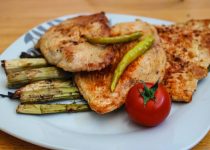How to Tie a Chicken for Ronco Rotisserie
Tying a chicken for the Ronco Rotisserie might seem like an intimidating task, especially if you're not accustomed to trussing poultry. But fear not, because with a few simple steps and a bit of practice, you'll be trussing like a pro in no time.
Imagine the succulent, evenly cooked bird, with crispy skin and tender, juicy meat, rotating in the rotisserie, ready to be served to your family and friends.
In this guide, we'll walk you through the process of selecting the right chicken, preparing it for trussing, and securing it for a perfect rotisserie cook.
Let's get started!
Selecting the Right Chicken
When selecting the right chicken for your Ronco Rotisserie, it's important to choose a fresh, plump bird that will result in juicy and flavorful meat for your meal.
Start by considering the size of the chicken. A bird that weighs between 3.5 to 5 pounds is ideal for the rotisserie. This size ensures even cooking and succulent meat.
To gauge freshness, look for plumpness and firmness in the chicken's breast and legs. The skin should be opaque and free from any discoloration or unpleasant odors. Check the expiration date if purchasing from a store. If possible, buy from a reputable butcher who can provide information about the chicken's source and handling.
Additionally, look for a chicken with a good amount of marbling, which indicates tenderness and flavor.
Choosing the right chicken is the first step to ensuring a delicious and satisfying meal from your Ronco Rotisserie. So, keep an eye out for a plump, fresh bird, and get ready to enjoy the juicy results in every bite.
Preparing the Chicken for Trussing
To prepare the chicken for trussing, start by selecting the right size chicken for your rotisserie. A bird that's around 4 to 5 pounds is ideal. Once you have your chicken, give it a thorough inspection for any defects or blemishes. Look for any cuts, tears, or bruises on the skin. Also, check for any remaining feathers or pin feathers that may have been overlooked during the cleaning process. Ensuring the chicken is free from defects won't only improve its appearance but also prevent any unwanted surprises during cooking.
Inspecting the chicken also allows you to familiarize yourself with its features, making it easier to truss later on. This step may seem small, but it sets the stage for a successful trussing process and ultimately impacts the presentation and flavor of your rotisserie chicken.
To prepare the chicken for trussing, pat the chicken dry with paper towels to remove any excess moisture and ensure a crispy, golden skin during the cooking process.
Trussing the Chicken With Kitchen Twine
Start by placing the chicken breast side up on a clean, flat surface. Trussing the chicken with kitchen twine is a crucial step to ensure even cooking and a beautiful presentation. When using twine, it's essential to choose the right type.
Cotton twine is a popular choice as it's heat-resistant and won't burn during roasting. As you begin trussing, consider knot tying techniques. The classic method involves crossing the twine underneath the tail and wrapping it around the ends of the drumsticks, then tying a secure knot. For an alternative trussing method, try using pre-made trussing pins for a quick and efficient trussing process.
It's also worth noting that trussing isn't limited to chickens. You can apply the same trussing principles to other meat cuts like turkey, beef, or pork to help them retain their shape and juiciness during roasting. Whether you're using butcher's twine, kitchen twine, or even silicone bands, mastering the art of trussing will elevate your cooking skills and impress your guests with perfectly cooked, beautifully presented dishes.
Securing the Wings and Legs
After trussing the chicken with kitchen twine, the next step is to secure the wings and legs for even cooking and a professional presentation. To achieve this, follow these steps:
- Cross and Tie the Wings:
Begin by tucking the wings underneath the chicken. Then, cross the kitchen twine over the wings and around the body. Tie it securely to hold the wings in place, ensuring they stay close to the body for even cooking.
- Position and Tie the Legs:
After securing the wings, position the legs close to the body. Cross the twine over the legs and around the body, then tie it tightly. This tying technique keeps the legs in place and prevents them from splaying out during cooking.
- Create a Professional Presentation:
As you secure the wings and legs, pay attention to the positioning to create a neat and professional appearance. A well-tied chicken not only cooks evenly but also presents beautifully when served.
- Double-Check for Security:
Before placing the chicken in the rotisserie, double-check the knots to ensure they're tight and secure. This will prevent any parts from coming loose during the cooking process.
Placing the Trussed Chicken in the Rotisserie
Once your chicken is securely trussed, carefully place it inside the rotisserie, ensuring that it's evenly balanced for optimal cooking. Before positioning the rotisserie, make sure it's on a flat, heat-resistant surface, with enough clearance around the appliance for proper ventilation. Preheat the rotisserie to the recommended temperature, typically around 375°F for poultry. This ensures that your chicken cooks evenly and reaches a safe internal temperature.
When placing the trussed chicken on the rotisserie spit, ensure that it's positioned in the center and balanced to prevent it from swinging during the cooking process. This will help the chicken cook evenly while maintaining its juiciness and tenderness. Once the chicken is secured on the spit, you can adjust the rotisserie settings according to the manufacturer's instructions.
Before starting the rotisserie, you can add additional seasoning or flavorings to the chicken if desired. This can enhance the taste and aroma of the chicken as it cooks, giving it a delicious and savory flavor.
Frequently Asked Questions
Can I Use a Different Type of Poultry, Such as Duck or Cornish Hen, With the Ronco Rotisserie?
You can use different poultry like duck or Cornish hen with the Ronco rotisserie. Try alternative trussing methods to ensure even cooking. Adjust cooking time accordingly. Experimenting with various birds can lead to delicious results!
How Do I Adjust the Cooking Time for a Larger or Smaller Chicken When Using the Ronco Rotisserie?
When using the Ronco Rotisserie, adjusting cooking time is crucial for different poultry options. For a larger chicken, add 5-10 minutes per pound, and for smaller ones, reduce by the same amount. Keep an eye on the internal temperature to ensure perfect doneness.
Can I Season the Chicken Before Trussing It, and if So, What Are the Best Seasonings to Use?
Before trussing, you can season the chicken. The best seasonings include salt, pepper, garlic, and herbs. Consider alternative poultry options like Cornish hens. Adjust cooking times based on their size for optimal results.
Is It Necessary to Use Kitchen Twine, or Are There Alternative Methods for Trussing the Chicken?
You don't need twine to truss a chicken. Try using silicone bands, skewers, or butcher's knots as alternative methods. Just make sure the chicken is secure for even cooking. Experiment with different trussing tips to find what works best for you.
What Are Some Common Mistakes to Avoid When Trussing a Chicken for the Ronco Rotisserie?
When trussing chicken for the Ronco rotisserie, common mistakes include tying too tightly, uneven trussing, and not securing the wings. Proper trussing ensures even cooking, crispy skin, and juicy meat. Mastering this technique elevates your rotisserie cooking game!



